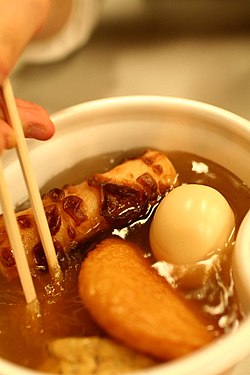Oden
This article includes a list of references, related reading, or external links, but its sources remain unclear because it lacks inline citations. (March 2013) |
 | |
| Type | Soup |
|---|---|
| Place of origin | Japan |
| Main ingredients | Boiled eggs, daikon, konjac, fishcakes, soy-flavored dashi broth |
Oden (おでん) is a Japanese dish consisting of several ingredients such as boiled eggs, daikon, konjac, and processed fishcakes stewed in a light, soy-flavored dashi broth. Ingredients vary according to region and between each household. Karashi is often used as a condiment.
Oden was originally what is now commonly called misodengaku or simply dengaku; konnyaku or tofu was boiled and eaten with miso. Later, instead of using miso, ingredients were cooked in dashi and oden became popular.
Oden is often sold from food carts. In recent years, some started offering oden round the year. Many different kinds of oden are sold, with single-ingredient varieties as cheap as 100 yen. Izakaya serves oden as well.
Regional variations
In Nagoya, it may be called Kantō-ni (関東煮) and soy sauce is used as a dipping sauce. Miso oden is simmered in Hatchomiso broth, which tastes lightly sweet. Konjac and tofu are common ingredients.
In the Kansai area, this dish is sometimes called Kanto-daki (関東煮 / 関東炊き) and tends to be more strongly flavored than the lighter Kantō version.[1]
Oden in Shizuoka uses a dark colored broth flavored with beef stock and dark soy sauce, and all ingredients are skewered. Dried and ground fish (sardine, mackerel, or katsuobushi) and aonori powder (edible seaweed) are sprinkled on top before eating.
Udon restaurants in Kagawa Prefecture in Shikoku almost always offer oden as a side dish, to be eaten with sweet miso while waiting for udon.
The dish was introduced to Taiwanese cuisine during Japanese rule and is referred to in Taiwanese Hokkien as olen (Pe̍h-ōe-jī: o͘-lián),[2] which has been further loaned into Taiwanese Mandarin as hēilún (Chinese: 黑輪). Tianbula (Chinese: 甜不辣; pinyin: tiánbùlà; lit. 'sweet', 'not spicy')[3] is a similar dish commonly sold at night markets. Despite using the same name as the Japanese tempura, Taiwanese tempura is more a variant of oden. Besides the more traditional ingredients, the Taiwanese olen also uses many local ingredients, such as pork meatballs and blood puddings. More recently, oden is offered in convenience stores where it is sold as guāndōngzhǔ (關東煮, from Kansai kanto-daki).
In China, 7-11 markets oden as haodun (好炖) a word play on "good pot."
In South Korea, odeng (오뎅) is a street food that is sold from small carts and is served with a spicy soup. It is very common on the streets of South Korea and there are many restaurants that have it on the menu or specialize in it. The term odeng is originally borrowed from Japanese, during the colonial era: unlike in Japan, odeng refers to the fish cake, not the whole dish. It is sometimes referred by its more native name eomuk (어묵) instead.
Popular ingredients


- Most common ingredients
- Boiled eggs
- Sliced daikon
- Konnyaku or Ito konnyaku
- Konbu
- Potato
- Tofu products: absorb dashi broth very well.
- Surimi products — in most cases, deep fried before simmering. Collectively called nerimono 練り物.
- Bakudan: boiled egg wrapped in surimi
- Chikuwa: thick tubes of surimi
- Gobomaki: boiled gobo (greater burdock, Arctium lappa, root) wrapped in surimi
- Ikamaki: squid wrapped in surimi
- Wiener-maki, or sausage-maki: wiener wrapped in surimi
- Less common or regional
- Surimi products
- Carrot
- Mushrooms, for example Shiitake
- Kabocha: Japanese squash
- Cabbage roll
- Tsukune: fish or meat balls
- Octopus
- Chikuwabu, gluten tubes. Popular in the Kantō region, but virtually unknown elsewhere.
- Suji: beef tendons, mainly in Kansai
- Tofu: mainly in Kansai, usually seared
- Tebichi: pig's trotters, only in Okinawa
See also
References
- ^ 関西ではなぜおでんを「関東煮」と呼ぶのか? (in Japanese). Nikkei Inc. February 2, 2013.
{{cite web}}: Unknown parameter|trans_title=ignored (|trans-title=suggested) (help) - ^ "Entry #31111 (oo33 lian51)". 臺灣閩南語常用詞辭典 [Dictionary of Frequently-Used Taiwan Minnan]. (in Chinese and Hokkien). Ministry of Education, R.O.C. 2011.
- ^ "Entry #31159 (thian35 pu55 lah3)". 臺灣閩南語常用詞辭典 [Dictionary of Frequently-Used Taiwan Minnan]. (in Chinese and Hokkien). Ministry of Education, R.O.C. 2011.
